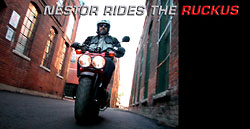
|
|
||||||||
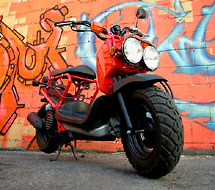 |
| "I am the Ruckus". |
"A Honda Ruckus," is my reply.
Nearly everyday that I had Honda's new scooter on Toronto roads, I was asked this, and many more questions. The follow-ups usually related to: how much, how fast, where can you get one, do you need a motorcycle license, how much for insurance, gas mileage, etc.
At times I felt like I was doing PR for Honda and their Ruckus. But I kinda didn't mind because I was in love with the little bugger.
 |
As luck would have it I got the Ruckus the day the power failed in Ontario. I was actually riding it when I noticed the lights go out. It made crossing intersections a bit more interesting and challenging but not really a problem. In the midst of a serious energy crisis, where no gas stations were working because of the lack of power, a scooter was the thing to have.
GO, GO AND GO
 |
| Nestor illustrates the ease at which the Ruckus gets by annoying obstacles. |
It should be noted that there is no way this scooter will smoke tires or do a wheelie, no matter how quickly you open up the throttle. Alas, there is no satisfying kick when you wind the throttle open. The acceleration is sedate but gets you going at reasonable pace.
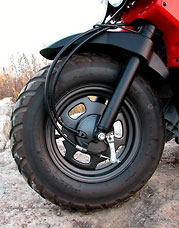 |
| Big fat tire, small drum brake. |
The only time the Ruckus really struggled with the speed of traffic was when I rode it on Toronto’s Lakeshore—where the Indy cars race—and in the suburbs, where the posted speed is the same as the Ruckus’ top speed. Since everybody does at least ten over, it was necessary to run the engine wide open for extended periods of time, which seemed fine with the Ruckus.
The fat ATV-type tires let the Ruckus handle all the ruts, streetcar tracks, construction zones and general disrepair that are the current streets of Toronto, with aplomb. The only time I felt the Ruckus getting squirrelly was when I hit some streetcar tracks during a turn in the rain. And that was for the briefest of moments. The Ruckus’ tires are great for city riding and even casual off-roading. They allowed some pretty extreme lean angles, even at slow speed.
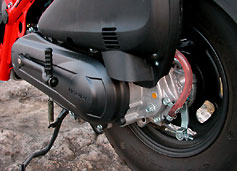 |
| Engine/swingarm assembly. |
The suspension proved adept at handling the potholes as well. The single shocked rear end was a bit on the soft side though. No doubt it was designed for svelte Japanese scooterists as opposed to well-fed North American types.
CONTROLS AND STOPPING
 |
| The most basic of instrumentation. |
The Ruckus has an automatic transmission—twist and go—with no clutch or gears to mess around with. That's about the only difference between the controls of the Ruckus and a motorcycle.
The brakes are interesting - they are drums for both front and rear, controlled by cables via the handlebar levers, just like a bicycle. I thought that this would be a detriment to the Ruckus but I did not find that to be so. The brakes hauled the scooter down from speed remarkably well. In the few emergency brake tests I performed in a deserted parking lot, and twice when I had to stop immediately in traffic, there was never any problem with the Ruckus’ stopping power.
A quirky thing on the braking system is the manual brake lock for the rear brake. It’s actually just a little tab that locks the rear brake lever in place. At first I though this was a silly feature but after time spent idling in up and down hill situations, I really appreciated being able to lock the rear brake and rest my hands.
OF GAS AND ACCESSORIES
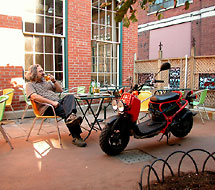 |
After a particularly good session, Nestor and the Ruckus relax over drinks. The Ruckus wonders if Nestor will call her in the morning ... |
Although new to our shores, the Ruckus has been sold in Japan for nearly two years, where it is called a Zoomer. As a result, many neat aftermarket accessories have been developed, and since Honda is still deciding which accessories it will bring in, I’ll add my opinion to this matter.
Exhaust kits - there are some
really wacked looking pipes in Japan.
Front basket and rear carry shelf.
A better rear shock.
Mesh side panels for the underseat area.
The backrest.
Disc brake kit (for the occasional stoppie).
The Ruckus is a really fun ride. Economical and environmentally friendly, it is the most fun you can have with five horsepower...and with attitude too!
MISS MIRYANA'S SECOND VIEW
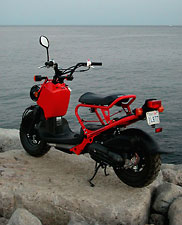 |
Scooters are no longer simply for snobbish, no-money-but-still-acting-posh, avant garde types. The Ruckus is ruggedly simple and smart in so many ways, that I almost needed wallpaper to list them.
With it's anti-scooter image comes a great design—tubular steel frame, hydraulic forks, easily adjustable drum brakes—which makes it a little simpler to work on. It's small and light, making for easy parking. Gas and insurance are CHEAP—a big bonus for under 25ers.
There are no fairings, so if you have a habit of dropping bikes, you'd probably never have anything to replace. There’s a big comfy seat, and lots of foot room, which I tested with a buddy's size 12 Sideshow Bob-like feet. Also anti-scooter is its non-temperamental 4-stroke engine, which makes the Ruckus quiet and environmentally friendly. It's almost cheaper than public transit—and oh so fun.THE LAUGH FACTOR
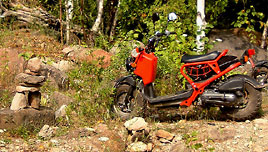 |
|
What is that stone thing that the Ruckus is looking at? Answers to the usual address. Photo: Miryana or her friend |
I laughed the whole way home after picking it up from Honda. Only a couple of hours earlier, I had ridden a 600cc sport bike, and now I was on this 50cc toy. There were only two points I ever held the throttle at—off or pinned. I got it to about 75 km/h hammering it down a steep hill, and couldn't stop laughing. Who knew being slow could be so enjoyable?
I began to envision a perfect world without cops, lawyers and insurance companies. And everyone was on a scooter. And there were no automotive fatalities, since scooters couldn't go dangerously fast. And the hole in the Ozone Layer would start to close, something that it would do every spring, summer and fall after a torturous winter of mass SUV usage. North Americans finally got it. It was beautiful.Then I woke up when a Yukon Denali following behind me passed me in my own lane. In my perfect world, Honda would have made an 80cc Ruckus, since there were countless times where topping out at 60km/h really, really, REALLY didn't cut it.
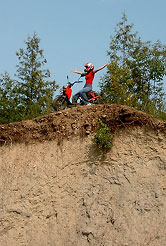 |
|
We're not sure what Miryana's doing here or what drug she was on at the time. Photo: Miryana's friend |
After a week of using it to commute, my Ruckus buddy, Paul, who recently bought one, suggested an off-roading trip. We had come to the conclusion that with those big, fat pieces of rubber that looked like snow tires, the Ruckus was just asking for it. Plus, I really had to know what's in a name.
Paul and I headed down roads we had frequently done on sport bikes at much faster speeds. And whenever we spotted suitable trails, we strayed from the main road.The Ruckus constantly surprised me with the way it climbed hills that were fairly steep, and the way it rumbled over tree roots, through five-foot-tall blades of grass, and other wonders of nature that kept trying to bring it down. The way it barrelled through the rugged terrain was absolutely astonishing. And the fact that it was so quiet made it seem like we were simply tip toeing through the forest. It seemed so right.
I also had the chance to use it as a pit bike at a track day at Mosport, brought home groceries in a box I stuffed underneath the seat, and double-rode my mom around the block. And still I never stopped laughing.Cheap, friendly and most of all, fun! Thank you Honda for understanding the motorist's needs and meeting them so well.
|
![]()
